This was published 6 years ago
Sea kayaking, West Papua: A new way to experience Indonesia's Raja Ampat islands
There's more to this new liveaboard sea kayaking trip in West Papua than paddling.
By Louise Southerden
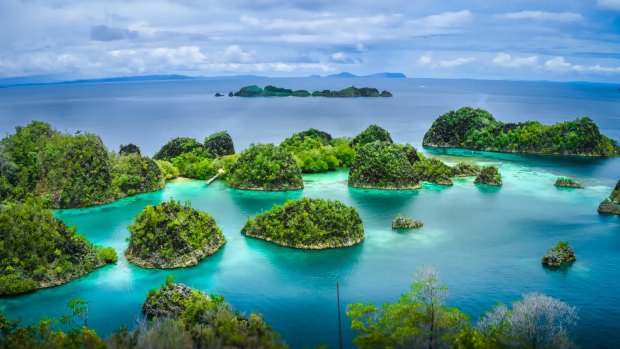
Don't let travel warnings put you off visiting the Raja Ampat islands.Credit: Shutterstock
From a distance, Equator Island is a chunk of shark-grey limestone with a stubble of rainforest, ringed by water as blue as a bottle of Bombay gin.
As we launch the kayaks from our ship and paddle closer, details come into view: kaleidoscopic coral gardens, fanning whitewater where sea meets reef, frigate birds tracing circles in the sky and a white-sand beach surrounded by high rock walls, secluded as a pirate's hideout.
What's most remarkable about Equator Island, however, is that it's just one of about 1500 karst limestone islands that make up Raja Ampat, an archipelago off the remote north-western tip of West Papua, the western half of the New Guinea island (formerly called Irian Jaya).
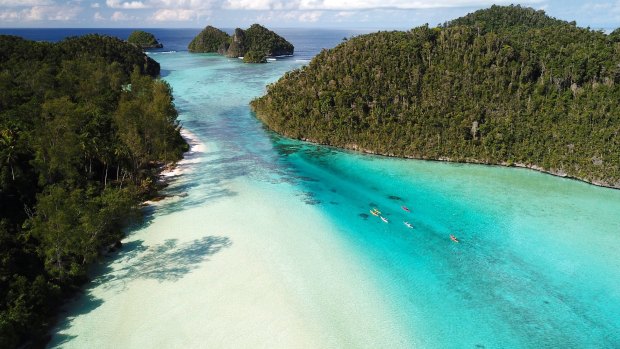
Paddling the shallows of Wayag Island in northern Raja Ampat.
Don't let its location put you off. Although the Australian Government's Smartraveller website advises "reconsidering your need to travel" to West Papua, that's because of regular clashes between Papuan pro-independence activists and Indonesian authorities on the eastern side of this vast province, hundreds of kilometres from the serenity of Raja Ampat.
PADDLING PARADISE
If you're a diver, you've probably heard of this group of islands whose name means "four kings" (referring to its four largest islands).
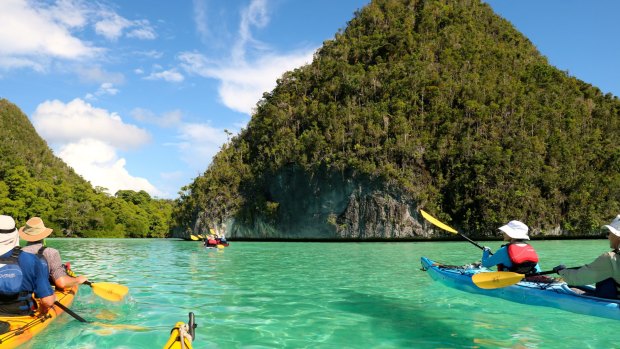
Paddling through Raja's karst islands.Credit: Louise Southerden
It's often ranked as one of the world's best dive destinations, for good reason: it's an oceanic Amazon with the highest recorded marine biodiversity on the planet including more than 1700 fish species (among them whale sharks and manta rays) and three-quarters of the world's corals (about 600 species).
Flying in to Sorong from Jakarta, via Sulawesi, I'd seen dozens of liveaboard dive boats anchored offshore.
I'm on a liveaboard boat too, not to dive but to test-paddle a new way to experience Raja Ampat: by sea kayak.
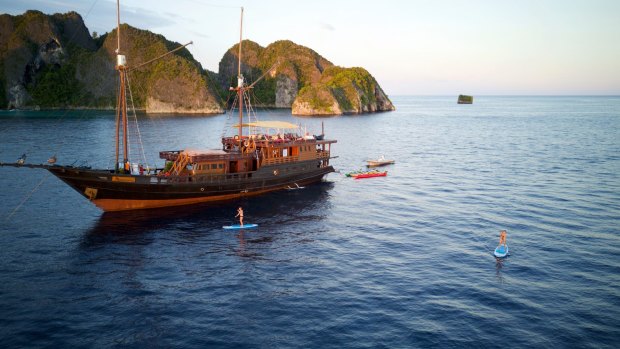
Sunset stand-up paddle boarding around the liveaboard boat.
Our Australian guide on this 10-day trip, Matt Edwards, pioneered liveaboard kayaking trips in Raja (as it's often called) in 2015. He'd been running camping-based trips in southern Raja for four years when he heard about a northern island called Wayag, which sounded perfect for paddling. So he hired a local fishing boat to take him there, with four intrepid friends.
"I remember pulling into Wayag and just thinking, 'Wow, this is the most amazing place I've ever been'," he tells us on our first day.
"There were no liveaboards, no pleasure craft, we had the place completely to ourselves. The coral reefs were preserved like nowhere else on the planet, like coral bleaching didn't exist. And the marine life was so plentiful we saw turtles, sharks and dolphins every day."
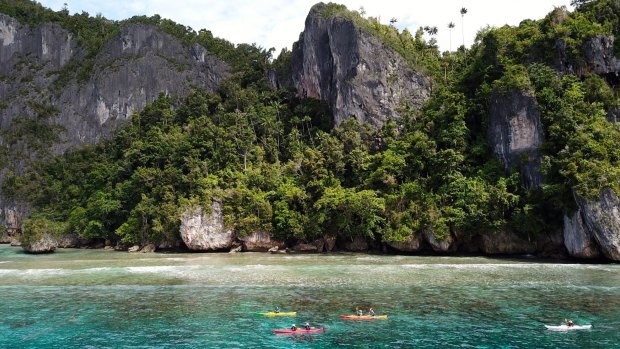
Paddling past high limestone walls on Quoy Island, northern Raja.
Matt and his friends spent the next 13 days paddling back to southern Raja.
"It was an awesome journey," he says, "but it was hard, with long days and big crossings. So the liveaboard idea was born: by chartering a boat we could access these really remote and incredible places in comfort."
EASY DOES IT
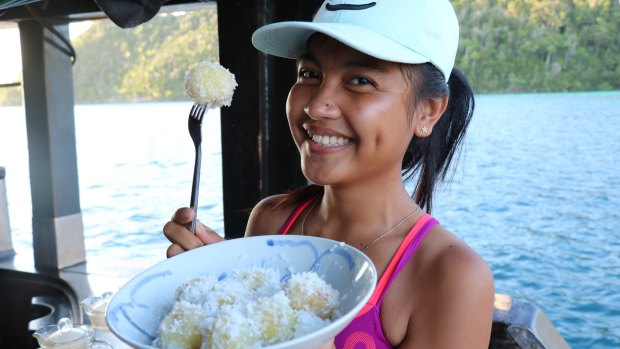
Ega, one of the crew, offering us a post-paddling snack of coconut balls.Credit: Louise Southerden
Our 42-metre liveaboard certainly is comfortable, a traditional Indonesian phinisi called Euphoria with air-conditioned en suite cabins, hot showers and sun lounges on the top deck.
The paddling is comfortable too. Most days the water is mirror-smooth (these trips run only in the windless dry season, October-December) and we take plenty of breaks to go snorkelling. One of the best things about the trip, in fact, is that we're not kayaking all day every day.
We do get to paddle a variety of seascapes, however. One day we're weaving through an archipelagic maze of green mushroom-shaped islands. The next we're cruising along the edge of a fringing reef beside sky-high limestone walls, surfing tiny waves into a peaceful lagoon alive with bird calls or drifting in silence through an eerie flooded forest (Raja happens to have the world's most diverse mangroves, which serve as nurseries for the tropical fish that populate its coral reefs).
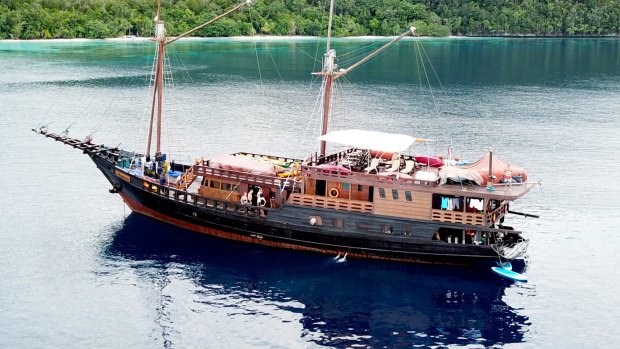
Liveaboard boat, the Euphoria, at anchor.
On the morning of day two we paddle through a long natural tunnel of rock so low we have to duck to avoid stalactites and darting microbats. Later, back on board for lunch, Matt admits he'd never been into that tunnel, despite having seen more of Raja from a sea kayak than anyone else. "Every trip we make a point of going somewhere new," he says. "So we're still exploring."
The Euphoria also lends the trip a swashbuckling air with its teak decks, twin masts, barefoot crew, ship's cat – and a sulphur-crested cockatoo called Rio which perches on Matt's shoulder during his nightly briefings.
TROPICAL CROSS-TRAINING
My favourite times of the day are sunrise and sunset: waking up with a swim off the back deck before breakfast and, at the dinner end of the day, kayaking home to the Euphoria at dusk to find it lit up like a floating lantern.
In between, we're in and out of the water like kids at a pool party, snorkelling several times a day (once at night), stand-up paddleboarding, even ocean swimming.
"Who wants to swim back to the boat?" someone will say while we're relaxing on the beach after snorkelling and a few of us will set off, freestyling out past the edge of the reef and over the bottomless blue. There are no big sharks or crocodiles to worry about, but we wear lycra leggings and rashees against harmless pink stinging jellyfish, and the tropical sun.
We have plenty of land-based adventures too, hiking through lush trackless rainforest to secret waterfalls, passing fan palms as big as golf umbrellas, and scrambling up craggy peaks for views.
One morning we do a pre-dawn bird of paradise tour with a Papuan guide to watch four male birds dancing like drag queens at the top of a tall tree, all orange feathers and attitude, though the highlight for me is seeing three giant hornbills flap audibly overhead like tropical pterodactyls.
Halfway through the trip we reach Matt's legendary Wayag Island where he launches a drone to give us an aerial view, of green marshmallow islets hemmed in see-through blue.
CLEARWAY AHEAD
Island-hopping in the kayaks that afternoon, we glide over water so swimming pool-clear it's like snorkelling without getting wet.
"It's the kind of water that makes you want to be baptised, that could cleanse you of all your sins and regrets," says Lizzie from Sydney.
It could be Phuket 40 years ago or Ha Long Bay before the boatloads of day-trippers. But Raja isn't the next Thailand, Vietnam or even Bali.
Instead it has its sights set on being a world-class sustainable tourism destination, using its growing popularity to protect the natural environment. The local government keeps tabs on the number of liveaboard boats and resorts, for instance, and cruise ships were temporarily banned last year.
Then there's this: a quarter of Raja, almost 12,000 square kilometres, is protected by a network of marine reserves, the first in Indonesia, which local communities monitor and patrol, funded by the environmental fees paid by tourists ($US100 per person).
Too soon it's our last afternoon. Matt takes us to a waterfall he'd found only the previous trip, where we swim in the deep green pool at its base until the light begins to fade. Then we walk back the way we'd come, emerging from the darkening jungle to find the sky ablaze with sunset pinks and oranges.
There's time for one last swim off the back of the boat before dinner, in liquid gold, time to linger on deck watching the first stars appear, still in our wet swimmers, not wanting this to end.
"Let's just live here forever," says Lizzie's 20-year-old daughter, Georgie. Sounds pretty good to me.
TRIP NOTES
MORE
FLY
Garuda Indonesia flies from Sydney, Melbourne and Perth to Sorong in West Papua via Denpasar (or Jakarta) and Makassar. Australians don't need a visa to stay in Indonesia for fewer than 30 days. The Wonderful Indonesia Travel Pass gives you up to 30 per cent off domestic airfares when you book your international flights with Garuda. See garuda-indonesia.com
KAYAK
Southern Sea Ventures runs 10 and 12-day Raja Ampat Kayak & Liveaboard Kayaking trips every October and November. Trips start at €4200 per person including accommodation in twin-share cabins with en suites, all meals, airport transfers and Raja Ampat environmental fee ($US100). See southernseaventures.com
Louise Southerden travelled as a guest of Southern Sea Ventures.
FIVE MORE THINGS TO DO IN RAJA AMPAT
DIVING
Scuba diving put Raja Ampat on the tourist map and is still its main activity. Choose between dive resorts (e.g. Raja Ampat Dive Resort) and liveaboard operators (e.g. Sea Safari Cruises); diveplanit.com has a good roundup of options.
MISOOL ECO RESORT
This award-winning ecolodge owned by a group of passionate divers and "eco-geeks" has its own 1200 square-kilometre marine reserve and just 19 rustic over-water bungalows and beach cottages. Rates from $US2400 per person for seven nights. See misool.info
BIRDING
Raja Ampat's natural wonders aren't just underwater. Sultan Birding Indonesia runs birdwatching trips on Waigeo Island, the only place in the world you'll find the curly-tailed Wilson's bird of paradise. See sultan-birding.com
VILLAGE LIFE
To sample island life in an authentic and affordable way you can't go past a homestay at a family-owned guesthouse. Just don't expect Wi-Fi or air-con. See stayrajaampat.com
PEARLS
Perth-based Atlas Pearls offers tours of its eco-pearling operation in southern Raja, one of its five South Sea pearl farms in Indonesia, by arrangement. See atlaspearls.com.au
Sign up for the Traveller Deals newsletter
Get exclusive travel deals delivered straight to your inbox. Sign up now.